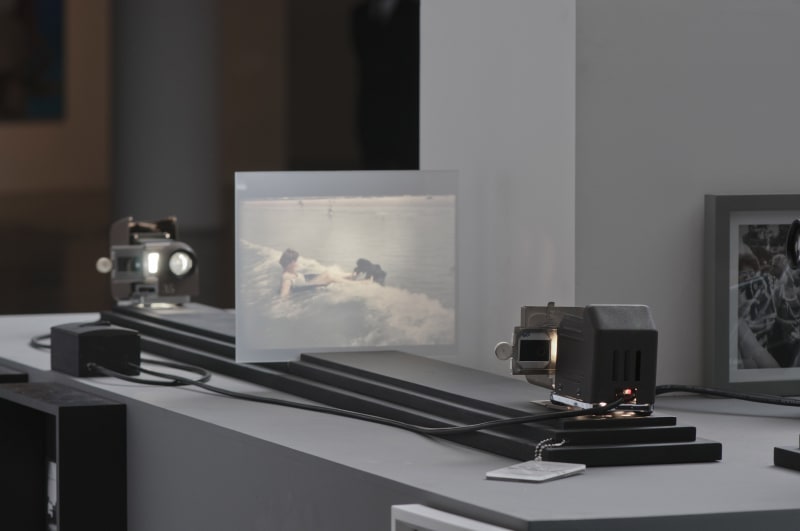Rosângela Rennó Gomes (Belo Horizonte, MG, 1962). Intermedia artist and photographer. The uniqueness of the artist lies in the way she resignifies the function of photography, as well as in the game she establishes between memory and oblivion, through the manipulation of photographs and objects collected from various archives in their relationship with the exhibition environment.
She graduated in architecture from the Universidade Federal de Minas Gerais (UFMG) in 1986, and in fine arts from Escola Guignard in 1987. In the late 1980s, she created her first works, based on photographs from family albums. In the series Conto de Bruxas (1988), she subverts the illustrations of children's stories and gives them a surrealistic character. In the series Pequena Ecologia da Imagem (1988), the artist appropriates, for the first time, photographs of anonymous people, which constitutes the central point of her work.
One of her main works focused on the issue of anonymity is Imemorial (1994), consisting of 3 x 4 portraits of people who worked on the construction of the city of Brasília in the 1950s, researched in the Public Archive of the Brazilian Federal District. By recovering these images and exposing them in another sociocultural context, Rennó seeks to arouse not only empathy for the subject represented, but also reflection on a past that is often forgotten or silenced.
According to Rosemary Gondim, the recontextualization of these images can "[...] lead us to conceive visions configured from new narratives and the production of subjectivities placed in new conditions of experience and fruition of the public" [1]. In this work of re-signification, Rosângela Rennó also provokes a reflection on photography as an object, more specifically on the social function that is attributed to it: to represent reality in an objective way.
In her quest to think about the discursivities of photography, in 1992, the artist started the project Arquivo Universal, which consists of a virtual database, composed of excerpts from journalistic texts that contain references to photographic images. Based on this database, Rosângela Rennó has produced, throughout her career, a series of art installations, such as In Oblivionem (1994/1995), consisting of three series of photographs articulated with fragments of texts: Álbum de Família (1994), Mulheres (1994) and No LandScape (1995).
The second series, called Mulheres, presents a photograph of a girl, similar to the ethnographic records of indigenous people, accompanied by a text in which Funai demands that a company pay compensation to a 15-year-old indigenous girl who was raped by its technicians while they were prospecting on indigenous lands. The relationship between image and text refers to the violence of the colonizers against the indigenous people in the process of conquest and colonization of Brazil. According to Talita Mendes, "the image of the photograph, in a state of disappearance, associated with the news materializes the erasure of plurality, of the other"[2].
Here we identify, once again, Rennó's concern in recovering, through the recontextualization of the image, that which is intentionally forgotten, in fact, silenced. In this work, by reflecting on the issue of representation, one can also highlight the influence of the American artist Joseph Kosuth (1945), one of the founders of conceptual art of the 1960s, in Rennó's work.
She received her doctorate in arts from the School of Communications and Arts at Universidade de São Paulo(ECA/USP) in 1997. She has received scholarships from the Civitella Ranieri Foundation, Umbertide, Italy (1995); the Vitae Foundation, Liechtenstein, Germany (1998); and the John Simon Guggenheim Memorial Foundation, New York (1999). He has held a series of solo exhibitions, such as Insólidos, in Lisbon (2015), and participated in group exhibitions, such as Passado/Futuro/Presente: Arte Contemporânea Brasileira no Acervo do Museu de Arte Moderna de São Paulo, in São Paulo (2019).
Rosângela Rennó contributes to Brazilian contemporary art both for her constant artistic innovations and for her quest to rescue the history of the forgotten, which, as much as the official history told in books, also constitutes the Brazilian narrative and cultural diversity.
Notes
1. GONDIM, Rosemary Monteiro. IMEMORIAL: fotografia e reconstrução da memória em Rosângela Rennó. Estudos de Sociologia, v. 1, n. 17, 2011. Available at: https://periodicos.ufpe.br/revistas/revsocio/article/view/235223/28248.
2. MENDES, Talita. In Oblivionem e o estado de desaparição da imagem: paradigmas de visualidade e escritura. In: ENCONTRO DE HISTÓRIA DA ARTE, 11., 2015. Anais… Campinas: Unicamp, 2015. p. 551. Available at:https://www.ifch.unicamp.br/eha/atas/2015/Talita%20Mendes.pdf.
ROSÂNGELA Rennó. In: ENCICLOPÉDIA Itaú Cultural de Arte e Cultura Brasileiras. São Paulo: Itaú Cultural, 2021. Available at: <http://enciclopedia.itaucultural.org.br/pessoa10376/rosangela-renno>. Accessed on: June 25, 2021. Encyclopedia entry. ISBN: 978-85-7979-060-7

